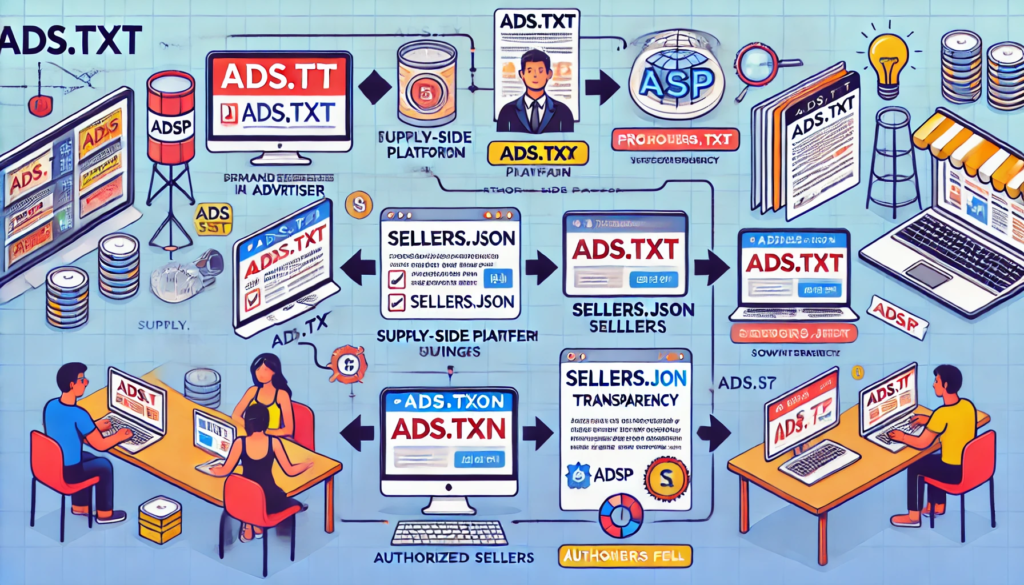
Introduction
The programmatic advertising ecosystem, valued at over $500 billion globally, is a powerhouse of efficiency and scale. However, its rapid growth has also attracted bad actors, leading to domain spoofing and revenue leakage. In 2023 alone, ad fraud cost the industry an estimated $81 billion, eroding trust between advertisers, publishers, and platforms. Enter Ads.txt and Sellers.json—two IAB Tech Lab initiatives designed to bring transparency, accountability, and cleanliness to programmatic supply chains. This blog dives into how these tools work, why they matter, and how they’re reshaping the future of digital advertising.
What Is Ads.txt?
Definition and Purpose
Ads.txt (Authorized Digital Sellers) is an IAB Tech Lab initiative introduced in 2017 to help combat ad fraud in programmatic advertising. It is a publicly accessible text file hosted on a publisher’s domain that lists all authorized digital sellers permitted to sell their ad inventory.
How Ads.txt Works
- Publishers create an Ads.txt file and upload it to their website’s root directory (e.g., example.com/ads.txt).
- The file contains information about authorized ad exchanges, resellers, and their corresponding account IDs.
- Advertisers and DSPs (Demand-Side Platforms) check this file before purchasing ad inventory to ensure they buy from legitimate sellers.
Example of an Ads.txt Entry
google.com, pub-1234567890123456, DIRECT, f08c47fec0942fa0
openx.com, 987654321, RESELLER, 123456789abcdef
- google.com → The ad exchange (Google Ad Manager)
- pub-1234567890123456 → The publisher’s account ID
- DIRECT → Indicates a direct relationship between the publisher and the exchange
- f08c47fec0942fa0 → Google’s certification ID
What Is Sellers.json?
Definition and Purpose
Sellers.json is another IAB Tech Lab initiative that complements Ads.txt. While Ads.txt is publisher-focused, Sellers.json provides transparency from the supply-side (SSPs, ad exchanges) to advertisers. It allows advertisers and DSPs to verify whether an entity selling ad inventory is a direct seller or a reseller.
How Sellers.json Works
- Ad exchanges and supply-side platforms (SSPs) host a Sellers.json file that lists all their sellers (both direct publishers and resellers).
- Advertisers can cross-check this data with Ads.txt files to verify the legitimacy of the inventory they are buying.
- Sellers are categorized as either DIRECT or RESELLER, similar to Ads.txt.
Example of a Sellers.json Entry
{
"seller_id": "pub-1234567890123456",
"name": "Example Publisher",
"domain": "example.com",
"seller_type": "PUBLISHER"
},
{
"seller_id": "reseller-987654321",
"name": "Ad Reseller Network",
"domain": "reseller.com",
"seller_type": "INTERMEDIARY"
}
- PUBLISHER → A direct seller who owns the inventory
- INTERMEDIARY → A reseller that facilitates ad placements
How Ads.txt and Sellers.json Interact
- Blocking Domain Spoofing
Domain spoofing is one of the ways that ad fraudsters misrepresent low-quality sites as premium publishers. Ads.txt prevents this because only authorized sellers can represent a publisher’s inventory. Sellers.json adds another layer to verify whether the seller really has a legitimate relationship with the publisher. - Increasing Supply Chain Transparency
Both Ads.txt and Sellers.json give visibility to the supply chain. Advertisers can cross-reference both files to see who’s actually involved in the buying and selling process, thus ensuring that their budget gets turned into actual valuable impressions as opposed to fraudulent traffic. - Reducing Arbitrage and Unauthorized Reselling
Some intermediaries buy ad inventory at a lower cost and then resell it at a higher price, adding no real value to the buyer. By analyzing Ads.txt and Sellers.json together, advertisers can filter out unnecessary intermediaries and purchase directly from publishers or trusted resellers.
Why Ads.txt and Sellers.json Are Crucial for a Clean Programmatic Ecosystem
1. Protecting Advertisers from Fraud
The money invested in programmatic campaigns by advertisers goes down the drain without transparency because of the existence of fraudulent traffic. Verification tools, such as ads.txt and sellers.json, help advertisers buy from authentic sources.
2. Ensuring Publishers Receive Fair Revenue
Without these tools, publishers risk losing revenue to fraudsters who impersonate their domains. By implementing Ads.txt, publishers can ensure that only authorized platforms sell their inventory, securing higher CPMs (cost per thousand impressions).
3. Strengthening Brand Safety
Many brands face risks of their ads appearing on inappropriate or fake websites. Ads.txt and Sellers.json help advertisers confidently choose trusted publishers, reducing risks associated with brand safety violations.
4. Enabling Programmatic Growth with Trust
The programmatic advertising industry continues to grow, but trust is essential. By ensuring a transparent ecosystem, these initiatives encourage more brands to invest in digital advertising, ultimately benefiting both advertisers and publishers.
Challenges and Limitations
1. Adoption Issues
While major publishers and ad networks have adopted Ads.txt and Sellers.json, some smaller publishers and resellers are still behind. This limits their effectiveness.
2. Complexity in Implementation
Setting up and maintaining these files requires technical knowledge. Some publishers might struggle to keep their Ads.txt file updated, leading to missed revenue opportunities.
3. Misuse by Intermediaries
Some networks falsely label themselves as “Direct” sellers when they are actually intermediaries. This reduces the effectiveness of these transparency tools.
Best Practices for Implementing Ads.txt and Sellers.json
- Keep Ads.txt Updated – Regularly review and update the file to ensure it reflects only active, authorized sellers.
- Verify Sellers.json Entries – Advertisers should cross-check Sellers.json files before buying inventory.
- Limit Resellers – Publishers should minimize the number of resellers in their supply chain to maximize transparency.
- Use Ad Verification Tools – Platforms like Google Ad Manager offer built-in tools to analyze Ads.txt and Sellers.json data.
- Educate Teams – Advertisers, publishers, and agencies should stay informed about best practices in supply chain transparency.
Final Verdict
With clean programmatic ecosystems comes Ads.txt and Sellers.json, essential components that bring transparency to the table, reducing fraud while protecting both advertisers and publishers from such bad actors in the digital advertising industry. Implementing and maintaining these standards really can increase revenue and foster trust among stakeholders, further ensuring the success of programmatic advertising.
As the industry matures, the more widespread adoption of Ads.txt and Sellers.json will be necessary for making digital advertising safer, more transparent, and more profitable for everyone involved.
No responses yet